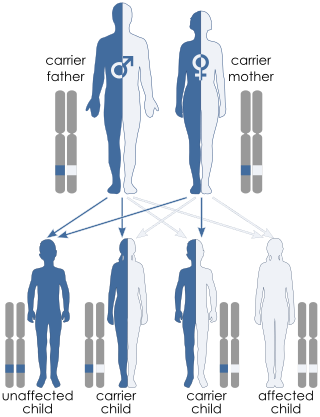
Lamellar ichthyosis, also known as ichthyosis lamellaris and nonbullous congenital ichthyosis, is a rare inherited skin disorder, affecting around 1 in 600,000 people.
Malouf syndrome is a congenital disorder that causes one or more of the following symptoms: mental retardation, ovarian dysgenesis, congestive cardiomyopathy, broad nasal base, blepharoptosis, and bone abnormalities, and occasionally marfanoid habitus.

Laurence–Moon syndrome (LMS) is a rare autosomal recessive genetic disorder associated with retinitis pigmentosa, spastic paraplegia, and mental disabilities.

Sjögren–Larsson syndrome is a rare autosomal recessive form of ichthyosis with neurological symptoms. It can be identified by a triad of medical disorders. The first is ichthyosis, which is a buildup of skin to form a scale-like covering that causes dry skin and other problems. The second identifier is paraplegia which is characterized by leg spasms. The final identifier is intellectual delay.
Acrodysostosis is a rare congenital malformation syndrome which involves shortening of the interphalangeal joints of the hands and feet, intellectual disability in approximately 90% of affected children, and peculiar facies. Other common abnormalities include short head, small broad upturned nose with flat nasal bridge, protruding jaw, increased bone age, intrauterine growth retardation, juvenile arthritis and short stature. Further abnormalities of the skin, genitals, teeth, and skeleton may occur.

Revesz syndrome is a fatal disease that causes exudative retinopathy and bone marrow failure. Other symptoms include severe aplastic anemia, intrauterine growth retardation, fine sparse hair, fine reticulate skin pigmentation, ataxia due to cerebellar hypoplasia, and cerebral calcifications. Its effects are similar to that of Hoyeraal-Hreidarsson syndrome. It is a variant of dyskeratosis congenita.

Björnstad syndrome is an autosomal recessive congenital condition involving pili torti, sensorineural deafness, and hair abnormalities. It was first characterized in 1965, in Oslo, by prof. Roar Theodor Bjørnstad after he observed an association between pili torti and hearing loss. The condition is extremely rare, with less than 50 cases documented in medical literature worldwide.

Trichothiodystrophy (TTD) is an autosomal recessive inherited disorder characterised by brittle hair and intellectual impairment. The word breaks down into tricho – "hair", thio – "sulphur", and dystrophy – "wasting away" or literally "bad nourishment". TTD is associated with a range of symptoms connected with organs of the ectoderm and neuroectoderm. TTD may be subclassified into four syndromes: Approximately half of all patients with trichothiodystrophy have photosensitivity, which divides the classification into syndromes with or without photosensitivity; BIDS and PBIDS, and IBIDS and PIBIDS. Modern covering usage is TTD-P (photosensitive), and TTD.

Marinesco–Sjögren syndrome (MSS), sometimes spelled Marinescu–Sjögren syndrome, is a rare autosomal recessive disorder.
Ichthyosis prematurity syndrome (IPS) is a dermatological disease with known genetic causes. This syndrome is a rare subcategory of autosomal recessive congenital ichthyosis (ARCI). It is associated with complications in the mid-trimester of a pregnancy leading to premature births. Although most prevalent in individuals of Scandinavian origin, there have also been scattered cases in people of Japanese, Italian and Indian ethnicity. This disorder is also referred to as ichthyosis congenital type IV.
Cerebral dysgenesis–neuropathy–ichthyosis–keratoderma syndrome is a neurocutaneous condition caused by mutation in the SNAP29 gene.

Wiedemann–Rautenstrauch (WR) syndrome, also known as neonatal progeroid syndrome, is a rare autosomal recessive progeroid syndrome. There have been over 30 cases of WR. WR is associated with abnormalities in bone maturation, and lipids and hormone metabolism.

Lowry-Wood syndrome, also simply known as LWS, is a very rare genetic disorder which is characterized by dysplasia of the epiphysis, low height/short stature, microcephaly, developmental delay, intellectual disabilities, and congenital nystagmus. Less common features include coxa vara and retinitis pigmentosa. Only 10 cases of this disorder have been described in medical literature. This disorder is associated with mutations in the RNU4ATAC gene, on chromosome 2q14.2








